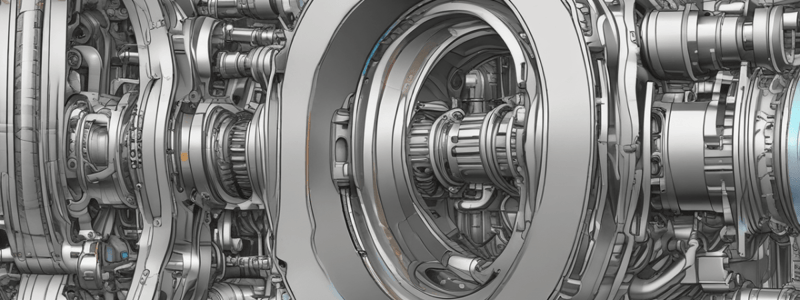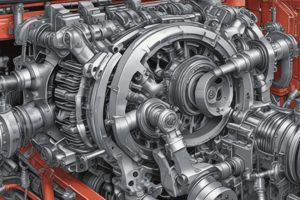Podcast
Questions and Answers
What is the primary reason for ensuring all oil passage drillings in the crankshaft are clean and free of obstructions?
What is the primary reason for ensuring all oil passage drillings in the crankshaft are clean and free of obstructions?
- To allow for proper inspection of the crankshaft (correct)
- To ensure the crankshaft is visually appealing
- To prevent damage to the crankshaft during lifting operations
- To maintain the weight of the crankshaft
What should you do if you come in contact with corrosive chemicals during the cleaning process?
What should you do if you come in contact with corrosive chemicals during the cleaning process?
- Wear breathing protection to avoid inhaling the fumes
- Follow recommended first aid procedures (correct)
- Use petroleum solvents to neutralize the chemicals
- Rinse the affected area with high-pressure water
Why is it important to keep compressed air and high-pressure water away from your body during the cleaning process?
Why is it important to keep compressed air and high-pressure water away from your body during the cleaning process?
- To maintain a clean work area
- To prevent damage to the crankshaft
- To ensure proper ventilation
- To avoid accidents and personal injury (correct)
What should you do before lifting heavy components during the cleaning process?
What should you do before lifting heavy components during the cleaning process?
What is the primary purpose of wearing personal protective equipment during the cleaning process?
What is the primary purpose of wearing personal protective equipment during the cleaning process?
Why is it important to familiarize yourself with WHMIS sheets for all chemicals and solvents involved in the cleaning process?
Why is it important to familiarize yourself with WHMIS sheets for all chemicals and solvents involved in the cleaning process?
What is the primary concern when oil passages are not properly cleaned?
What is the primary concern when oil passages are not properly cleaned?
What is the purpose of coating the crankshaft with light preservative oil and wrapping it in plastic?
What is the purpose of coating the crankshaft with light preservative oil and wrapping it in plastic?
What is the recommended course of action for damaged threads in the crankshaft?
What is the recommended course of action for damaged threads in the crankshaft?
What is the purpose of inspecting the seal surface area on the crankshaft?
What is the purpose of inspecting the seal surface area on the crankshaft?
What is the recommended method for removing a worn wear sleeve from a crankshaft?
What is the recommended method for removing a worn wear sleeve from a crankshaft?
What is the most accurate method for detecting cracks in a crankshaft?
What is the most accurate method for detecting cracks in a crankshaft?
Why is it essential to inspect the crankshaft main bearing, connecting rod bearing, and thrust surfaces?
Why is it essential to inspect the crankshaft main bearing, connecting rod bearing, and thrust surfaces?
What is the recommended method for cleaning the crankshaft?
What is the recommended method for cleaning the crankshaft?
What happens if more than half of the threaded holes in the crankshaft are damaged?
What happens if more than half of the threaded holes in the crankshaft are damaged?
Why is it crucial to blow dry the crankshaft with compressed air after washing?
Why is it crucial to blow dry the crankshaft with compressed air after washing?
What is the primary concern when inspecting a crankshaft?
What is the primary concern when inspecting a crankshaft?
Why should the spindle of the micrometer be positioned carefully when measuring the journal surface?
Why should the spindle of the micrometer be positioned carefully when measuring the journal surface?
What is the purpose of measuring the distance between the thrust surfaces of a crankshaft?
What is the purpose of measuring the distance between the thrust surfaces of a crankshaft?
How is crankshaft straightness typically checked?
How is crankshaft straightness typically checked?
What is the purpose of regrinding journals of a crankshaft?
What is the purpose of regrinding journals of a crankshaft?
What is stamped on the front counterweight of a reground crankshaft?
What is stamped on the front counterweight of a reground crankshaft?
Why should crankshafts with cracks in critically loaded areas generally be replaced?
Why should crankshafts with cracks in critically loaded areas generally be replaced?
What is the purpose of measuring the main and connecting rod journals?
What is the purpose of measuring the main and connecting rod journals?
Who should interpret cracks to determine the reusability of a crankshaft?
Who should interpret cracks to determine the reusability of a crankshaft?
What is the purpose of checking the straightness of a crankshaft?
What is the purpose of checking the straightness of a crankshaft?
What is the purpose of grinding a crankshaft's journals?
What is the purpose of grinding a crankshaft's journals?
Why are undersize bearings used in a reground crankshaft?
Why are undersize bearings used in a reground crankshaft?
What is the purpose of reboring a block's bearing bore?
What is the purpose of reboring a block's bearing bore?
How are bearings commonly identified?
How are bearings commonly identified?
What happens to the distance between the thrust surfaces when they are reground?
What happens to the distance between the thrust surfaces when they are reground?
What is the purpose of inspecting the crankshaft gear?
What is the purpose of inspecting the crankshaft gear?
Why is it necessary to consult the manufacturer's service information for crankshaft gear removal and installation?
Why is it necessary to consult the manufacturer's service information for crankshaft gear removal and installation?
What is the purpose of removing the crankshaft gear?
What is the purpose of removing the crankshaft gear?
What is the result of grinding a crankshaft's journals to different undersizes?
What is the result of grinding a crankshaft's journals to different undersizes?
What is the purpose of hard chromium plating or welding a worn crankshaft journal?
What is the purpose of hard chromium plating or welding a worn crankshaft journal?
Flashcards are hidden until you start studying
Study Notes
Safety Precautions
- Wear personal protective equipment (eye protection, apron, gloves, hearing protection, breathing protection) when working with corrosive chemicals, petroleum solvents, high-pressure water, steam cleaning, and compressed air.
- Keep compressed air and high-pressure water away from the body.
- Work in a well-ventilated area when using chemicals and solvents.
- Familiarize yourself with WHMIS sheets for all chemicals and solvents involved in cleaning processes.
- Follow recommended first aid procedures if you come in contact with corrosive chemicals.
Crankshaft Cleaning
- Clean the crankshaft thoroughly before inspection to remove oil and deposits.
- Use petroleum solvent, hot tank, mechanical parts washer, or steam cleaner to clean the crankshaft.
- Blow the crankshaft dry with compressed air after cleaning.
- If not reinstalling the crankshaft immediately, coat it with light preservative oil and wrap it in plastic to prevent rust formation and dirt contamination.
Crankshaft Inspection
- Visually inspect the crankshaft main bearing, connecting rod bearing, and thrust surfaces for scoring and ridging.
- Inspect machined surfaces (journals and fillet areas) for discoloration, which indicates excess heat.
- Inspect threaded holes in the nose and flange for damaged threads.
- Inspect the seal surface area for grooves, and polish out minor grooves (less than 0.010" or 0.25 mm) for reuse.
Crack Detection
- Check crankshafts for cracks using dye check, magnetic particle, or fluorescent magnetic particle (Magnaflux) methods.
- Inspect critical areas of loading on the crankshaft for fatigue cracks.
Measurement
- Measure machined and load-bearing surfaces of the crankshaft to determine serviceability.
- Measure main and connecting rod journals to determine wear, out of round, and taper.
- Measure the distance between thrust surfaces to determine thrust surface wear.
- Check crankshaft straightness or runout using V-blocks and a dial indicator.
Crankshaft Reconditioning Procedures
- Straighten crankshafts if runout is within manufacturer's limits, but recheck for cracks after straightening.
- Regrind journals that are worn beyond manufacturer's minimum specifications to an undersize dimension.
- Use undersize bearings on reground crankshafts to provide correct bearing clearance.
- Oversized bearings can be installed in oversized bores.
Studying That Suits You
Use AI to generate personalized quizzes and flashcards to suit your learning preferences.




